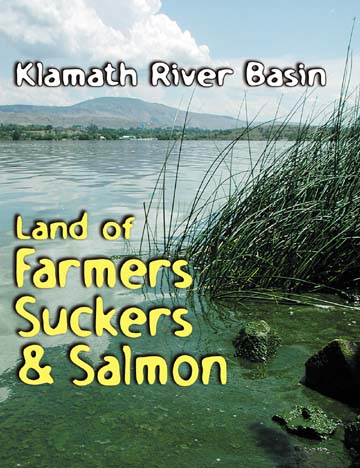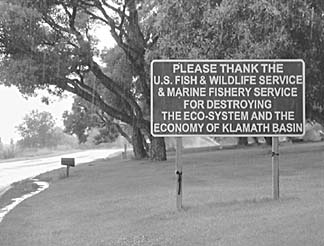| Story & photos by SETH ZUCKERMAN FARMER ROB CRAWFORD FIXES THE VISITOR ACROSS THE CAFÉ TABLE with his steady blue gaze and says, "If there aren't drastic changes this year, there won't be a next year." Crawford and his brother John raise wheat, potatoes, onions, barley and mint on more than 1,000 acres of prime soil in the former bed of Tule Lake just south of the Oregon-California border. But federal agencies have cut off the flow of irrigation water to him and 1,400 other farms in the area to provide for the needs of three imperiled fish species in this drought year. In the arid upper Klamath basin, where a normal year brings three inches of rain during the growing season, that means finding other water supplies or giving up on farming for the year. The federal ruling raised the stakes in a decade-long controversy that pits farm families against Indian tribes, fishermen and the health of the 15,600-square-mile Klamath watershed. It highlights the difficulty of crafting a fair and effective plan to bring species back from the edge of extinction under the terms of the Endangered Species Act, and stands as a reminder that nature's gifts vary from year to year in ways that are bound to clash with an economic system that demands a predictable annual return. The federal water cutoff -- prompted by the U.S. Fish and Wildlife Service and the National Marine Fisheries Service -- aims to keep Upper Klamath Lake relatively high through the summer to protect endangered fish known as the shortnosed and Lost River suckers, and to provide enough water for Klamath River coho salmon In the aftermath of the water ruling, thousands of affected farmers and their neighbors rallied in protest, and a few took the law into their own hands and repeatedly opened the headgates from Upper Klamath Lake into the irrigation canals (in photo at right). Although the water was soon shut off, that move demonstrated the depth of feeling about the federal decision. Even beyond the civil disobedience, signs on businesses and truck bumpers around Klamath Falls attest to local sentiment. "Support the American Farmer -- Amend the ESA" [Endangered Species Act] reads one. "Farms, not fish," another. Hundreds of miles downriver, the situation looks quite different. "There are people behind the fish -- tribes, commercial and sport fishermen whose lives depend on that water source," says Yurok Tribe Executive Director Troy Fletcher. "The management of that water project controls the flow to the mainstem of the Klamath River, which is a major concern so fish can migrate out to sea." The affected farmers have the bad luck to be clients of the federal government, which must take closer account of endangered species than other agencies. Upstream, an equal 200,000 acres of farmland are drawing their full water allocation from private and local irrigation projects. And yet a gallon of water left in the rivers that feed Upper Klamath Lake would do just as much good for the fish as a gallon that is kept from flowing out of the lake for agriculture. Similarly, irrigation continues unabated on lower tributaries of the Klamath such as the Scott and Shasta rivers in Siskiyou County. "The Scott goes bone-dry in the summertime," says Fletcher. "You can debate how much water fish really need, but it's hard to say they don't need any."
Protest signs in Klamath Basin area Upper Klamath farmers will likely receive $20 million in aid now making its way through Congress, but they would rather be farming. They aim their anger both at the law that affects them disproportionately and at the science behind the water cut-off. They point out that some of the worst fish kills have occurred in years when the lake has been high, and that the suckers survived droughts in 1992 and 1994 without significant die-offs, even though the lake was drawn down to low levels. Biological research reveals a more complicated picture, driven by an interaction of wind speed, lake depth and nutrient levels. "Nothing can be done in Upper Klamath Lake to eliminate the possibility of fish kills," says Larry Dunsmoor, fisheries biologist for the Klamath Tribes, composed of the Klamath, Modoc and Yahooskin peoples. "All you can do is manage to minimize the size of the algae blooms and the chance of fish kills." These phenomena are the product of an ecosystem which no longer functions as it once did. Early Euro-American settlers diked and dried up wetlands in the region. Then, in 1918, hydroelectric dams below Upper Klamath Lake blocked salmon from reaching spawning grounds in the rivers that feed the lake. From the 1920s to the '40s, the U.S. Bureau of Reclamation drained most of Tule Lake and Lower Klamath Lake for agriculture, and built an irrigation canal to send Upper Klamath Lake water to farms in the neighboring Tule Lake basin. Efforts to protect the suckers began about 10 years ago and focused on restoring their habitat. Tens of thousands of acres of former wetlands were purchased from willing farmers and flooded with water again. Not only do these marshes nurture sucker larvae, they absorb nutrients that would otherwise enter the lake from farm runoff and aggravate the algae blooms that endanger adult suckers. Other projects -- undertaken partly at landowner expense -- have fenced cows out of creeks where they were trampling streamside vegetation, screened intakes to keep fish from being sucked into irrigation ditches, and provided off-creek watering troughs so that cattle would spend less time in streambeds.
"That project would have decreased community income, so there'd be fewer people fighting for water rights," says Chad Rabe, a veterinarian from that area who is active in watershed groups. The Northcoast Environmental Center's Tim McKay takes a dim view of Connelly's objections. "Farmers have been at the table stonewalling for 10 years," he says. "We can do `feel-good' projects, but in the meantime water keeps going to highly subsidized crops and fish keep dying." That conflict over water is inevitable, because more water has been promised for habitat and irrigation in the basin than is available in a drought year. The list of claimants is long: indigenous fishermen seeking suckers in the upper basin and salmon below, farmers, and two federal wildlife refuges covering parts of Tule and Lower Klamath lakes. Those refuges are going without water this year, because their supply depends on the excess water applied to farmers' fields that drains into the lakes. Refuge manager Phil Norton estimates that supplying farmers and the refuges requires half a million acre-feet of water per year, while meeting the needs of the coho and suckers as well would nearly double that to 900,000 acre-feet. (An acre-foot is enough water to cover an acre one foot deep.) Although it is natural for rainfall to vary from year to year, irrigation districts and the federal Bureau of Reclamation have historically faced pressure to maintain full deliveries to farmers so they can maintain livestock herds and meet economic commitments such as loan payments and produce contracts. Once the amount of promised water exceeds what the basin can provide in a dry year, the economic system is no longer compatible with the ecosystem. Conventional economies fail to account for the variability of nature, and inevitably lead to bitter conflicts like the one afoot this summer. Indigenous economies worked differently.
These days, the tribal economy leans harder on casino gaming than wild game, but the Klamath tribes relied on the fish for millennia as a staple of their diet and have been the suckers' strongest advocates. Pressure from the tribes was instrumental in listing the fish as endangered in 1989. The water ruling represents a victory for the 3,300-member tribe, which saw its reservation whittled away from 2.2 million acres to 880,000 acres by the mid-20th century. In 1954, an act of Congress terminated the tribe's sovereign status and put the reservation land into the national forest system. The tribe regained recognition in 1986 and is fighting to reclaim its reservation. "We've been hearing from agricultural interests how the government betrayed them and is taking away their rights and their land," says Foreman. "We're not unfamiliar with what they're saying -- this is the same song we've sung for years." That sense of betrayal permeates the Klamath basin these days, as each group presses the government to honor its promises to them at the expense of others. While the regulatory arena might offer a legally defensible solution, it is unlikely to craft a fair or sensible one. Even U.S. Fish and Wildlife Service biologist Ron Larson admits that the Endangered Species Act is a poor way to resolve these disputes. "The act should be a last resort, an emergency ward for biodiversity," he says. "Just like in health care, you want to do the preventive work up front." While cropland goes fallow under the dictates of the act, the region reaps a bumper harvest of irony. Some farmers go without, while others flood their fields to raise alfalfa and potatoes on land that would rather grow sagebrush. One branch of the U.S. Fish and Wildlife Service decided to shut off water to refuges managed by another division of the same agency. Farmers employ tactics such as rallies and civil disobedience more commonly used by their opponents. And the western water doctrine of "first in time, first in right" is being ignored, with private irrigators watering full bore while the irrigators in the federal project watch their fields go dry, even though their water rights are older and would normally take precedence. This year's wild juvenile salmon face an uncertain future because the drought makes it harder for them to get to the ocean, but returns of adult coho salmon to hatcheries in Oregon and Washington are expected to overwhelm the need for brood stock. As a result, more than 100,000 salmon fillets will likely be made available to food banks -- some of them in the hard-hit Klamath basin. The supreme irony may yet strike in August, if thousands of suckers die in Upper Klamath Lake regardless of the federal decision to keep the lake high -- which could easily happen if the winds die down for several days while the algae bloom is decaying. In the face of these ironies, the best solution lies in proposals to buy out willing farmers and retire some land from production, or at least cut the farms' water needs to bring their demands into balance with the basin's reliable water supply. Conservation groups have options on about 30,000 acres of farmland at $3,000 to $4,000 per acre. And across the road from the U.S. Fish and Wildlife office in Klamath Falls, research agronomist Don Clark of Oregon State University Extension is experimenting with flax seed, a less thirsty crop. Other grains also require less water than potatoes or alfalfa, but they wouldn't return a profit in today's commodity markets. Last week parties to the lawsuits over Klamath water met for court-ordered mediation in Eugene, Ore., to seek a fairer division of the basin's limited water than this year's Endangered Species Act showdown provided. They will need to find creative solutions if agriculture and wildlife are to share the Klamath basin. Despite the current crisis, veterinarian Chad Rabe, a 29-year-old native of the area, is still searching for farmland of his own here. "I know there's a future in agriculture, because people need to eat," he says. "At first I was devastated by [the water cutoff]. But I see people being creative to keep going and make a living. I feel like I can join with them and become one of those people." With that kind of innovation and tenacity, the Klamath basin may remain a land of farmers, suckers and salmon, as it has been for the last century.
Petrolia writer Seth Zuckerman covers environmental issues in the West for the Tidepool.org news service, where this article first appeared. Comments? E-mail the Journal: [email protected] © Copyright 2001, North Coast Journal, Inc. |


![[photo of Headgates]](cover0726-headgates.jpg) downstream.
downstream.![[photo of sign: "No water, no barley, no beer"]](cover0726-nobeer.jpg)

![[photo of Mike Connelly]](cover0726-cows.jpg) Ironically, the water cut-off has jeopardized further efforts like these. "The deal was, `You can avoid the regulatory hammer by being pro-active,' " says rancher Mike Connelly, chairman of the Klamath Watershed Council. (In photo at right) "How do I go to my neighbors now and tell them they should do this?" The irrigation ruling has weakened Connelly's hand with other farmers, who were already skeptical of projects that idle agricultural land. That resistance runs so deep that a watershed group on an Upper Klamath Lake tributary blocked a plan last year to restore 2,000 acres of wetland habitat, even though the landowners were willing to sell.
Ironically, the water cut-off has jeopardized further efforts like these. "The deal was, `You can avoid the regulatory hammer by being pro-active,' " says rancher Mike Connelly, chairman of the Klamath Watershed Council. (In photo at right) "How do I go to my neighbors now and tell them they should do this?" The irrigation ruling has weakened Connelly's hand with other farmers, who were already skeptical of projects that idle agricultural land. That resistance runs so deep that a watershed group on an Upper Klamath Lake tributary blocked a plan last year to restore 2,000 acres of wetland habitat, even though the landowners were willing to sell. "The economy of agriculture is to utilize the water to grow the crop to sell for money to be able to survive," says Klamath Tribal Council Chairman Allen Foreman. (In photo at left) "They spend that money at the grocery store. Well, the region here is our grocery store. Our economy is based on using directly what the system produces. When that product is gone, our economy goes down the tubes."
"The economy of agriculture is to utilize the water to grow the crop to sell for money to be able to survive," says Klamath Tribal Council Chairman Allen Foreman. (In photo at left) "They spend that money at the grocery store. Well, the region here is our grocery store. Our economy is based on using directly what the system produces. When that product is gone, our economy goes down the tubes."![[map of Klamath Basin area, with photos of Shortnosed Sucker fish and Lost River Sucker fish]](cover0726-map.jpg)